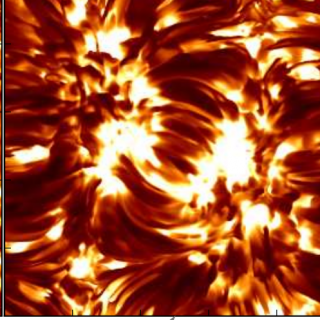Bibcode
Kano, R.; Trujillo-Bueno, J.; Winebarger, A.; Auchère, F.; Narukage, N.; Ishikawa, R.; Kobayashi, K.; Bando, T.; Katsukawa, Y.; Kubo, M.; Ishikawa, S.; Giono, G.; Hara, H.; Suematsu, Y.; Shimizu, T.; Sakao, T.; Tsuneta, S.; Ichimoto, K.; Goto, M.; Belluzzi, L.; Štěpán, J.; Asensio Ramos, A.; Manso Sainz, R.; Champey, P.; Cirtain, J.; De Pontieu, B.; Casini, R.; Carlsson, M.
Referencia bibliográfica
The Astrophysical Journal Letters, Volume 839, Issue 1, article id. L10, 6 pp. (2017).
Fecha de publicación:
4
2017
Número de citas
57
Número de citas referidas
52
Descripción
There is a thin transition region (TR) in the solar atmosphere where the
temperature rises from 10,000 K in the chromosphere to millions of
degrees in the corona. Little is known about the mechanisms that
dominate this enigmatic region other than the magnetic field plays a key
role. The magnetism of the TR can only be detected by polarimetric
measurements of a few ultraviolet (UV) spectral lines, the Lyα
line of neutral hydrogen at 121.6 nm (the strongest line of the solar UV
spectrum) being of particular interest given its sensitivity to the
Hanle effect (the magnetic-field-induced modification of the scattering
line polarization). We report the discovery of linear polarization
produced by scattering processes in the Lyα line, obtained with
the Chromospheric Lyman-Alpha Spectro-Polarimeter (CLASP) rocket
experiment. The Stokes profiles observed by CLASP in quiet regions of
the solar disk show that the Q/I and U/I linear polarization signals are
of the order of 0.1% in the line core and up to a few percent in the
nearby wings, and that both have conspicuous spatial variations with
scales of ˜10 arcsec. These observations help constrain theoretical
models of the chromosphere-corona TR and extrapolations of the
magnetic field from photospheric magnetograms. In fact, the observed
spatial variation from disk to limb of polarization at the line core and
wings already challenge the predictions from three-dimensional
magnetohydrodynamical models of the upper solar chromosphere.
Proyectos relacionados

Magnestismo Solar y Estelar
Los campos magnéticos son uno de los ingredientes fundamentales en la formación de estrellas y su evolución. En el nacimiento de una estrella, los campos magnéticos llegan a frenar su rotación durante el colapso de la nube molecular, y en el fin de la vida de una estrella, el magnetismo puede ser clave en la forma en la que se pierden las capas
Tobías
Felipe García

Magnetismo, Polarización y Transferencia Radiativa en Astrofísica
Los campos magnéticos están presentes en todos los plasmas astrofísicos y controlan la mayor parte de la variabilidad que se observa en el Universo a escalas temporales intermedias. Se encuentran en estrellas, a lo largo de todo el diagrama de Hertzsprung-Russell, en galaxias, e incluso quizás en el medio intergaláctico. La polarización de la luz
Ernest
Alsina Ballester